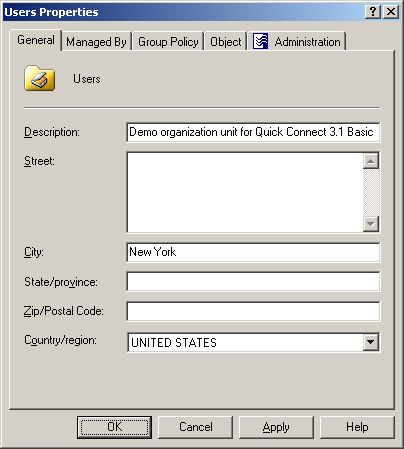To modify properties of an OU, right-click the OU, and then click Properties. You can make changes to OU properties in the Properties dialog box, shown in the following figure.
Figure 21: Modifying Organizational Unit properties

In the Properties dialog box, some property labels may be displayed as hyperlinks. The hyperlink indicates that Active Roles enforces certain policy restrictions on the property. To examine policy details, click the hyperlink: the policy information is displayed (see Getting policy-related information earlier in this document).
The policy information is also displayed whenever you supply a property value that violates a policy restriction. Property changes cannot be applied until you enter an acceptable value.
You can use the Properties dialog box to view or modify any property of the Organizational Unit: go to the Object tab and click Advanced Properties. In the Advanced Properties window you can manage all properties, including those that cannot be accessed via the Properties dialog box itself.
You can also display the Advanced Properties window as follows: right-click the Organizational Unit and select All Tasks | Advanced Properties.
To modify Organizational Unit properties
- In the console tree, locate the Organizational Unit you want to modify.
- Right-click the Organizational Unit, and then click Properties to display the Properties dialog box for that Organizational Unit.
- Use the tabs in the Properties dialog box to view or modify properties of the Organizational Unit.
- If you want to view or modify additional properties (those for which the tabs in the Properties dialog box do not provide data entries), go to the Object tab and click Advanced Properties.
- After setting all the properties you want, click OK.
|

|
NOTE:
- You can also access the Advanced Properties dialog box for an Organizational Unit as follows: Right-click the Organizational Unit and select All Tasks | Advanced Properties.
- You can use the Find function of Active Roles in order to locate the Organizational Unit that you want to modify. Once you have found the Organizational Unit, you can open the Properties dialog box as follows: Right-click the Organizational Unit in the list of search results and click Properties.
|
To rename an OU, right-click the OU, and click Rename. Type the new name and press ENTER.
To rename an Organizational Unit
- In the console tree, locate the Organizational Unit you want to rename.
- Right-click the Organizational Unit, and then click Rename.
- Type a new name, and then press ENTER.
|

|
NOTE:You can use the Find function of Active Roles in order to locate the Organizational Unit that you want to rename. Once you have found the Organizational Unit, you can rename it as follows: Right-click the Organizational Unit in the list of search results and click Rename. |


